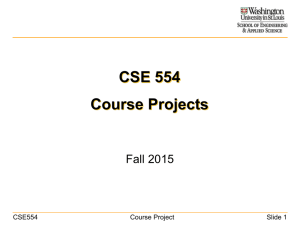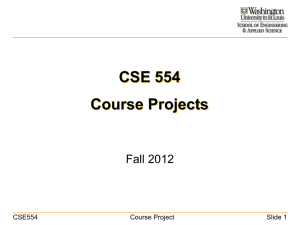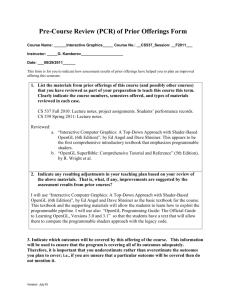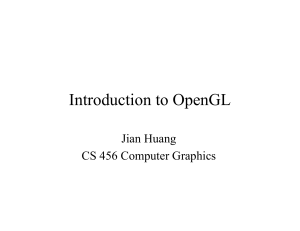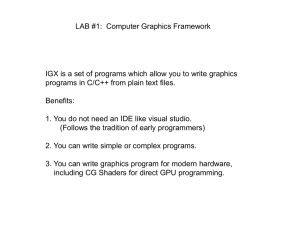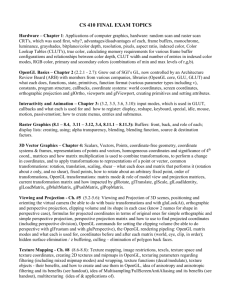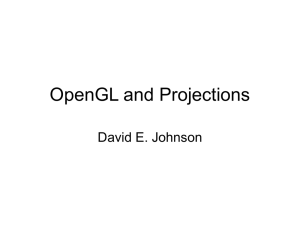Introduction to OpenGL Jian Huang
advertisement
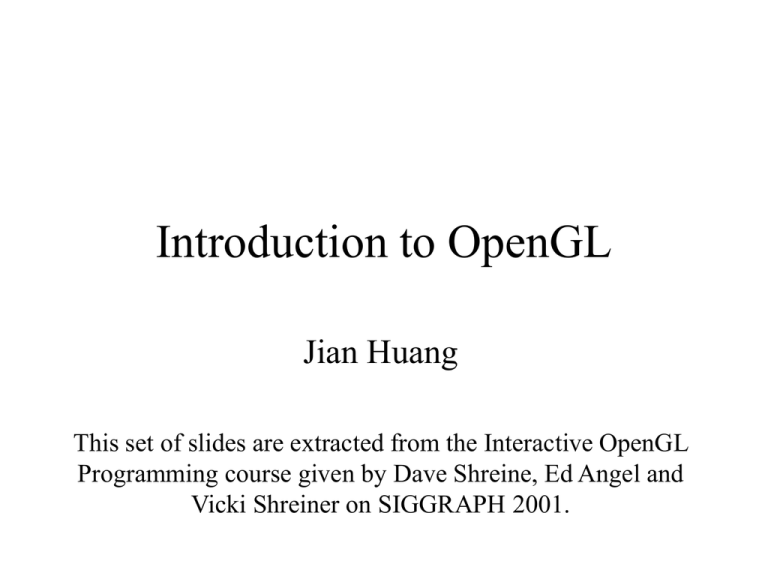
Introduction to OpenGL
Jian Huang
This set of slides are extracted from the Interactive OpenGL
Programming course given by Dave Shreine, Ed Angel and
Vicki Shreiner on SIGGRAPH 2001.
OpenGL and GLUT Overview
• What is OpenGL & what can it do for
me?
• OpenGL in windowing systems
• Why GLUT
• GLUT program template
What Is OpenGL?
• Graphics rendering API
– high-quality color images composed of
geometric and image primitives
– window system independent
– operating system independent
OpenGL Architecture
OpenGL as a Renderer
• Geometric primitives
– points, lines and polygons
– Image Primitives
– images and bitmaps
• separate pipeline for images and geometry
– linked through texture mapping
• Rendering depends on state
– colors, materials, light sources, etc.
Relate APIs
• AGL, GLX, WGL
– glue between OpenGL and windowing systems
• GLU (OpenGL Utility Library)
– part of OpenGL
– NURBS, tessellators, quadric shapes, etc
• GLUT (OpenGL Utility Toolkit)
– portable windowing API
– not officially part of OpenGL
OpenGL and Related APIs
Preliminaries
• Header Files
– #include <GL gl.h>
– #include <GL glu.h>
– #include <GL glut.h>
• Libraries
• Enumerated types
• OpenGL defines numerous types for
compatibility
– GLfloat, GLint, GLenum, etc.
GLUT Basics
•
•
•
•
Application Structure
Configure and open window
Initialize OpenGL state
Register input callback functions
– render
– resize
– input: keyboard, mouse, etc.
• Enter event processing loop
Sample Program
void main( int argc, char** argv )
{
int mode = GLUT_RGB|GLUT_DOUBLE;
glutInitDisplayMode( mode );
glutCreateWindow( argv[0] );
init(); // initiate OpenGL states, program variables
glutDisplayFunc( display ); // register callback routines
glutReshapeFunc( resize );
glutKeyboardFunc( key );
glutIdleFunc( idle );
glutMainLoop(); // enter the event-driven loop
}
OpenGL Initialization
• Set up whatever state you’re going to use
void init( void )
{
glClearColor( 0.0, 0.0, 0.0, 1.0 );
glClearDepth( 1.0 );
glEnable( GL_LIGHT0 );
glEnable( GL_LIGHTING );
glEnable( GL_DEPTH_TEST );
}
GLUT Callback Functions
• Routine to call when something happens
– window resize or redraw
– user input
– animation
• “Register” callbacks with GLU
– glutDisplayFunc( display );
– glutIdleFunc( idle );
– glutKeyboardFunc( keyboard );
Rendering Callback
• Do all of our drawing here
glutDisplayFunc( display );
void display( void )
{
glClear( GL_COLOR_BUFFER_BIT );
glBegin( GL_TRIANGLE );
glVertex3fv( v[0] );
glVertex3fv( v[1] );
glVertex3fv( v[2] );
glEnd();
glutSwapBuffers();
}
Idle Callbacks
• Use for animation and continuous
update
glutIdleFunc( idle );
void idle( void )
{
t +=dt;
glutPostRedisplay();
}
User Input Callbacks
• Process user input
glutKeyboardFunc( keyboard );
void keyboard( char key, int x, int y )
{
switch( key ) {
case ‘q’ : case ‘Q’ :
exit( EXIT_SUCCESS );
break;
case ‘r’ : case ‘R’ :
rotate = GL_TRUE;
break;
}
}
Elementary Rendering
• Geometric Primitives
• Managing OpenGL State
• OpenGL Buffers
OpenGL Geometric Primitives
• All geometric primitives are specified by
vertices
Simple Example
void drawRhombus( GLfloat color[] )
{
glBegin( GL_QUADS );
glColor3fv( color );
glVertex2f( 0.0, 0.0 );
glVertex2f( 1.0, 0.0 );
glVertex2f( 1.5, 1.118 );
glVertex2f( 0.5, 1.118 );
glEnd();
}
OpenGL Command Formats
Specifying Geometric
Primitives
• Primitives are specified using
glBegin( primType );
glEnd();
• primType determines how vertices are combined
GLfloat red, greed, blue;
Glfloat coords[3];
glBegin( primType );
for (i =0;i <nVerts; ++i ) {
glColor3f( red, green, blue );
glVertex3fv( coords );
}
glEnd();
OpenGL Color Model
• Both RGBA (true color) and Color Index
Controlling Rendering
• Appearance
• From Wireframe to Texture mapped
OpenGL’s State Machine
• All rendering attributes are
encapsulated in the OpenGL State
– rendering styles
– shading
– lighting
– texture mapping
Manipulating OpenGL State
• Appearance is controlled by current state
for each ( primitive to render ) {
update OpenGL state
render primitive
}
• manipulating vertex attributes is most
common way to manipulate state
– glColor*() / glIndex*()
– glNormal*()
– glTexCoord*()
Controlling current state
• Setting State
glPointSize( size );
glLineStipple( repeat, pattern );
glShadeModel( GL_ SMOOTH );
• Enabling Features
glEnable( GL_ LIGHTING );
glDisable( GL_TEXTURE_2D );
Transformations in OpenGL
• Modeling
• Viewing
– orient camera
– projection
• Animation
• Map to screen
Coordinate Systems and
Transformations
• Steps in Forming an Image
–
–
–
–
specify geometry (world coordinates)
specify camera (camera coordinates)
project (window coordinates)
map to viewport (screen coordinates)
• Each step uses transformations
• Every transformation is equivalent to a
change in coordinate systems
3D Transformations
• A vertex is transformed by 4 x 4 matrices
• all affine operation are matrix multiplication
• matrices are stored column-major in OGL
• matrices are always post-multiplied
• v in perspective projection, the
Except
fourth
row = (0,0,0,1), w left unchanged.
• Mv
OpenGL uses stacks of matrices, the
programmer must remember that the last
matrix specified is the first applied.
Specifying Transformations
• Programmer has two styles of specifying
transformations
– specify matrices glLoadMatrix, glMultMatrix
– specify operation glRotate, glOrtho
• Programmer does not have to remember the
exact matrices
• check appendix of Red Book
Programming Transformations
• Prior to rendering, view, locate, and orient:
– eye/camera position
– 3D geometry
• Manage the matrices
– including matrix stack
• Combine (composite) transformations
• Transformation matrices are part of the state, they must be
defined prior to any vertices to which they are to apply.
• OpenGL provides matrix stacks for each type of supported
matrix (ModelView, projection, texture) to store matrices.
Transformation Pipeline
Matrix Operations
• Specify Current Matrix Stack
– glMatrixMode( GL_MODELVIEW or GL_PROJECTION )
• Other Matrix or Stack Operation
– glLoadIdentity() glPushMatrix() glPopMatrix()
• Viewport
– usually same as window size
– viewport aspect ratio should be same as
projection transformation or resulting image may
be distorted
– glViewport( x, y, width, height )
Projection Transformation
• Perspective projection
– gluPerspective( fovy, aspect, zNear, zFar )
– glFrustum( left, right, bottom, top, zNear, zFar )
(very rarely used)
• Orthographic parallel projection
– glOrtho( left, right, bottom, top, zNear, zFar)
– gluOrtho2D( left, right, bottom, top )
– calls glOrtho with z values near zero
• Warning: for gluPerspective() or
glFrustum(), don’t use zero for zNear!
Applying Projection
• Transformations
• Typical use ( orthographic projection)
glMatrixMode( GL_PROJECTION );
glLoadIdentity();
glOrtho( left, right, bottom, top, zNear, zFar );
Viewing Transformations
• Position the camea/eye in the scene
• To “fly through” a scene
• change viewing transformation and redraw
scene
gluLookAt( eye x ,eye y ,eye z ,
aim x ,aim y ,aim z ,
up x ,up y ,up z )
• up vector determines unique orientation
• careful of degenerate positions
Modeling Transformations
• Move object
– glTranslate{fd}( x, y, z )
• Rotate object aro nd arbitrary axis
– glRotate{fd}( angle, x, y, z )
– angle is in degrees
• Dilate (stretch or shrink) object
– glScale{fd}( x, y, z )
(yx
Projection is left handed
• Projection transformation (gluPerspective,
glOrtho) are left handed
– think of zNear and zFar as distance from view
point
• Everything else is right handed, including the
vertexes to be rendered
Common Transformation
Usage
• Example of resize() routine
– restate projection & viewing
transformations
• Usually called when window resized
• Registered a callback for
glutReshapeFunc()
resize(): Perspective & LookAt
void resize( int w, int h )
{
glViewport( 0, 0, (GLsizei) w, (GLsizei) h );
glMatrixMode( GL_PROJECTION );
glLoadIdentity();
gluPerspective( 65.0, (GLfloat) w / h,
1.0, 100.0 );
glMatrixMode( GL_MODELVIEW );
glLoadIdentity();
gluLookAt( 0.0, 0.0, 5.0,
0.0, 0.0, 0.0,
0.0, 1.0, 0.0 );
}
